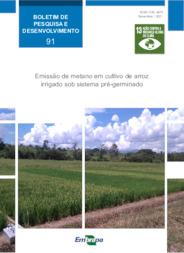Embrapa Tabuleiros Costeiros
 Publicações
Publicações
Emissão de metano em cultivo de arroz irrigado sob sistema pré-germinado.
Autoria: LIMA, M. A. de; VIEIRA, R. F.; LUIZ, A. J. B.; GALVAO, J. A. H.
Resumo: Resumo: O metano (CH4) é um dos principais gases de efeito estufa provenientes de atividades agrícolas, sendo o arroz irrigado por inundação uma importante fonte. Estudos locais de mensuração de fluxos de gases de efeito estufa em áreas agrícolas têm sido incentivados em nível global com o intuito de subsidiar e refinar estimativas nacionais e estaduais de emissão, bem como validar modelos biogeoquímicos. Este estudo teve como objetivo quantificar a emissão sazonal de CH4 em cultivo de arroz irrigado no município de Tremembé, SP, uma das principais áreas produtoras de arroz deste estado. O experimento foi conduzido na safra de 2008/2009, e utilizou o método de câmara fechada e cromatografia gasosa. Com base na emissão sazonal foi possível estimar o fator de emissão de CH4 (FE, 6.2 kg CH4 ha-1 dia-1) e o seu potencial de aquecimento global parcial (pPAG, 26.2 Mg CO2 eq estação de crescimento-1 ha-1), e o PAGp escalonado pelo rendimento de grãos (PAGpR, 3.9 kg CO2 eq kg-1 grão-1), que se apresentou no contexto da faixa de emissões sazonais encontrada em outras regiões do Brasil. O estudo mostrou elevada emissão sazonal de CH4 na área estudada, atribuída, principalmente, ao longo do período de inundação e, possivelmente, às características da variedade utilizada. -- Abstract: Methane (CH4) is one of the main greenhouse gases derived from agricultural activities considering that flood-irrigated rice represents an important source. Local studies on measurement of greenhouse gas flow from agricultural areas has been encouraged at the global level in order to subsidize and to refine national and state emission estimates as well as to validate the biogeochemical models. This study aimed to quantify the seasonal emission of CH4 in the irrigated rice cultivation at the municipality of Tremembé, State of São Paulo, which is one of the main rice production area in this State. The experiment was carried out within the years of 2008/2009 harvest, using the closed chamber method and gas chromatography. Based on the seasonal emission, it was possible to estimate the CH4 emission factor (EF, 6.2 kg CH4 ha-1 day-1) and its partial global warming potential (pGWP, 26.2 Mg CO2 eq growing season-1 ha-1) and the pGWP staggered by grain production (YpGWP, 3.9 kg CO2 eq kg-1 grain), that presented itself in the context of the range of seasonal emissions found in other regions of Brazil. The study showed high seasonal emission of CH4 at the studied area, attributed mainly to the long period of flooding and to the characteristics of the variety used.
Ano de publicação: 2021
Tipo de publicação: Folhetos
Unidade: Embrapa Meio Ambiente
